Data-Driven Marketing Strategy: The Basics for Success
Tara McGlamery Account Strategist#Digital Marketing, #Digital Strategy

Building a data-driven marketing strategy can be frustrating and wrought with analysis paralysis. But it doesn’t have to be. Learn what data you should be tracking, what analysis tools can ease the burden, and how to help your organization adopt a data-driven culture.
Raise your hand if you’ve ever been personally victimized by analysis paralysis. Don’t worry, you’re not alone. Marketing directors and managers tend to accumulate overwhelming amounts of data, ranging from customer experience data to marketing campaign results, —leaving their marketing teams to tackle the tedious task of deciphering multiple reports to apply to their marketing efforts. Unfortunately, there’s not a one-size-fits-all solution to this problem because your approach may be vastly different from other industries, your competitors, or even from other departments within your organization. What I’ve noticed from all types of businesses, is that there are three similar and consistent points of frustration with analytics strategies: analytics strategies have gone stale, the wrong tools are being used or not used to their full potential, and data is being siloed or not shared. So, knock the dust off those digital marketing reports you keep filing away to your “read later” folder and let’s get a handle on your analytics strategy once and for all.
Laying the Foundation through Planning
When working with clients, I always start by asking:
- Do your Key Performance Indicators (KPIs) clearly reflect your goals?
- Are you tracking how your brand is perceived across all digital marketing channels?
- Are you taking user feedback and other customer data to improve your products or services?
- Do you routinely check the quality of your marketing data?
- Are you governing your analytics? (Are you GDPR and CPA compliant?)
- Are you sharing your marketing data with other stakeholders?
- And do you honestly know what your customers / target audiences want?
While I can easily go more in-depth on each of these points, let’s take a holistic approach. Your analytics strategy should be much the same as your other marketing strategies; ever-changing and always provide value. So, trite but true, it is vital that you build a strong foundation for data-driven business decisions with continuous, incremental improvements. I recommend starting by assigning KPIs to every aspect of your digital goals and SWOT analysis. With this as your foundation, you should be able to answer the majority of the questions above and be able to build a clear strategy from your findings.
Track the Right Data
The first step is to make sure you are tracking the right data. At a minimum, track the following:
Web Site
- Bounce rates
- Traffic sources
- Devices used
- Click through rates (CTR’s)
- Conversion Rates
- Page/Site weights and speeds
- Server response times
Social Media
- Sentiments by channel
- Share of Voice (SoV) amongst your competitors
- Trending hashtags/keywords
- Estimated reach
- Top channels for sharing
Email Marketing
- Overall Open Rate
- CTA submissions per device
- Bounce rates
Organic (SEO)
- Rankings based on your industry standards
- Search volume
- Referrals
- Organic search visits
Ads
- The total cost of your ad
- Cost per click
- Cost per conversion
- Click-through rate
These metrics are fairly standard and are likely already readily available in your current analytics systems. However, in order to receive the real value from these metrics, you must be able to rely on the data you are collecting. Filtering your owned IP addresses and irrelevant sources from your data is a great first step to minimalize noise, but it is also imperative to categorize your data and automate where possible. The real key to successful data management and analysis is segmentation and filtration.
Digital Analytics Tools of the Trade
In a swirl of different internal processes, suppliers, and contracts, it’s no surprise that most businesses are struggling with how to find the right tools for the entirety of their organization. While the thought of asking your marketing team to learn and adopt a new tool might be downright agonizing, it may be worth the investment to re-evaluate your current software stack; especially if your existing marketing tools are not providing value.
Here are some baseline features to look for when evaluating analytics tools:
- User-friendly interface
- Easily exportable reports
- Proactive or predictive features
- Automation
- Multiple integration options
- Shows ROI
The tools you choose should not consume the majority of your marketing budget for the year unless it truly provides a profitable return. Ultimately, the tool(s) you select should do more than simply churn reports with out-of-the-box metrics. They should be easily interpreted, adopted, and scalable for your team. If a new tool is not in your budget this year, reach out to your Diagram contact today to check out what tools we offer and recommend as a part of our managed services.
If you want to go it alone, here are some of my favorite digital analytics tools:
- Website – Google Analytics, New Relic, Hotjar, and Visitor Intelligence (for Episerver clients)
- Social – HubSpot, Sprout Social, Digimind, Socialbakers, and BuzzSumo
- SEO– Moz, SEMrush
- Email – Hubspot, Drip, and Customer.io
Tying it All Together
Now that we’ve identified the metrics you need to track, found tools to help you track them. it’s time to bring it all together. So, how do you overcome having more than 5 different reports hitting your inbox or valuable reports hitting other team member’s inboxes without your knowledge? While it may be almost impossible to avoid using multiple pieces of software to provide insights, it’s not impossible to tie them all together into one cohesive system. I recommend using Software as a Service (SaaS) products like Domo, Tableau, or Google Data Studio to tie all your insights tools together to help unify your data into a singular, user-friendly location and avoid a siloed outcome. Typically, these tools offer multiple integrations (even Episerver, HubSpot, and Umbraco) to combine your data into one system that all appropriate members of your organization can access to help prevent interdepartmental data silos.
However, even with the most sophisticated tools, your success still hinges on one important aspect; adoption. You’ve likely heard the term, data-driven culture, floating around for years, but adopting a data-driven culture goes beyond the theory of analytics usage. It requires tearing down the walls of internal competition where each department independently operates, and instead, build an environment where ideas can be shared to improve decision-making. In order to see the whole picture, collaboration must be baked into every aspect and every channel of your digital strategy. While there is certainly nothing wrong with applying individual experience and intuition to your strategies, your theories should still be tracked.
Let’s say your goal is to increase social traffic to your e-commerce site by 8% this month. Your KPIs for this goal should be focused on new customer acquisition, behavior, and conversions. Start by breaking your strategy into three separate steps: Collect the right data, analyze, and review.
- Collect the metrics from each of the channels you are tracking with this campaign. In this case: website sessions, % of new sessions, bounce rates, pages per session, post social shares, estimated reach, and keyword mentions associated with the campaign.
- Analyze your findings to detect how successful your campaign was, who it resonated the most with, when it generated the most traffic, and what aspects were most successful. These marketing insightsshould help drive future marketing decisions.
- Finally, review your findings with your stakeholders. Did you meet your goal? If so, what helped make it successful? If not, what can you do differently next time based on your analysis?
At the end of the day, the challenge with data-driven marketing does not simply stem from how to showcase your data and see if you’ve met your goals, but how to accurately and holistically tell the story of your findings. It’s likely that your data won’t always reflect positive results; which isn’t necessarily a bad thing. The objective of applying analytics to your strategy is to use data to learn in order to grow. The more information your organization can gather collectively, whether it’s by website traffic observations, social reviews/mentions, better understanding the customer journey, or preferences in content engagement, the better equipped you’ll be to make necessary adjustments to capture your audience. And with the steps provided above, you should be able to take action and utilize your data to help your company succeed across all digital channels.
Related Posts
Integrating Qualitative Data into Business Strategies
Discover how collecting, analyzing, and integrating qualitative data into your business strategy can enhance marketing insights and drive growth.

The Google Leak and Creating Content That Doesn't Suck
This year's leak of Google's internal SEO documents underscored the need for web content that doesn't suck. But here's what else we learned...
Results Matter.
We design creative digital solutions that grow your business, strengthen your brand and engage your audience. Our team blends creativity with insights, analytics and technology to deliver beauty, function, accessibility and most of all, ROI. Do you have a project you want to discuss?
Like what you read?
Subscribe to our blog "Diagram Views" for the latest trends in web design, inbound marketing and mobile strategy.
